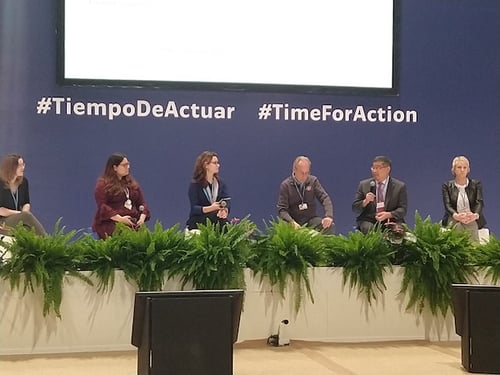Published on
Call it a Climate Emergency: How Higher Education Institutions Can Support Climate Action

“One in three species threatened by extinction.”
“Forty percent of the Antarctic ice melting—don’t call it climate change, call it climate emergency.”
Such were the billboards in the Madrid subway station greeting attendees at the recent United Nations climate conference held in December. Greta Thunberg was there, leading her followers, recognizable from the green stripes under their eyes, in cheers and jeers. But the actual negotiations were proceeding slowly, if at all, with much backtracking by countries on their commitments for carbon reduction, and disagreements between the rich and the more vulnerable countries about how to distribute the costs of climate change equitably.
Are we making progress, or is the world sure to face catastrophe, with global temperatures rising more than two degrees Celsius by the end of the century, and ushering in dire consequences for species extinction, rising sea levels and extreme weather calamities?
Visitors and participants in the conference could find evidence both ways. Negotiations are producing far less than hoped for, and the United States’ withdrawal from the Paris Agreement cast a pall over the proceedings, causing other nations to reconsider their own respective commitments. On the other hand, the conference showed an amazing and impressive amount of planning, policy and action related to carbon reduction.
Several countries had pavilions offering information and presentations about their climate action work in progress. While the U.S. did not have a governmental pavilion, We Are Still In, a coalition of American cities, states, businesses, education and nonprofit organizations, managed its own Climate Action Center at the conference, with dozens of powerful examples of local climate change efforts underway. We were there as representatives of Second Nature, a nonprofit that brings together more than 400 institutions of higher education that have pledged to become carbon neutral, and that have made huge progress over the last decade. Together, the organizations that are part of We Are Still In represent two thirds of the U.S. population.

We were encouraged by a presentation in the Turkish pavilion about the country’s national planning for carbon reduction, as well as the Bangladesh Climate Change Strategy and Action Plan. That there were pavilions from smaller countries like Serbia, the Central African Republic, Tunisia, and Colombia, as well as behemoths like China, India, and the European Union, demonstrated the geographic breadth of involvement and dedication.
Indeed, there were times during our five days at the conference that we felt very hopeful. The amount of work underway to address the many, varied aspects of climate change clearly has huge momentum. Policy makers, academics, activists, funders and businesses have created a mass movement that seems likely to accelerate regardless of decisions by any one government.
At our respective institutions, we’ve made operational changes that affect the way we do business, making it more sustainable. For example, as of now, Lewis & Clark College has divested of 50% of its fossil-fuel investments, and is on track to be fully divested from public fossil-fuel holdings by the end of 2022. Meanwhile, Portland Community College has agreed to purchase off-site power through Portland General Electric’s new Green Future impact program, which is anticipated to offset energy emissions by 20%. And despite its footprint growth, PCC has reduced energy use per square foot by 51% since 2006 due to overall sustainability efforts.
Perhaps the current U.S. federal stance is a global aberration. As the effects of climate change become ever more visible and disastrous, and as other governments and a plethora of non-governmental organizations embrace activism to thwart climate change, the U.S. will have no choice but to join the battle. However, precious years will have slipped away, years whose cost will be measured in lives lost and suffering caused by extreme weather events.
Therefore, we stand with those who call it not just climate change, but a climate emergency, and we remain committed to having our institutions be leaders on education, research and best practices to achieve carbon neutrality.
Author Perspective: Administrator
Author Perspective: Community College



